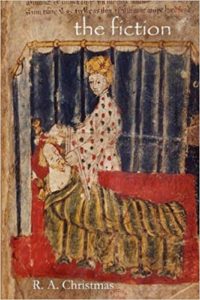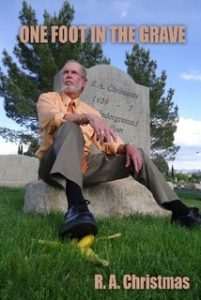 Christ Climbed Down Again–and Again
Christ Climbed Down Again–and Again
Title: the fiction
Author: R. A. Christmas
Publisher: Lulu Press
Genre: Fiction, novel in short stories
Year Published: 2018
Number of Pages: 237
Price:$19.99
“and that, my friend, explains how square I really am”
–Rick Robinson in a letter to his friend Fenworthy.
One of my fond early memories of Dialogue was a piece in Summer 1972. It listed John D. Lee as the author, about a third of the way down the page, with the note,
“at his execution,
Mountain Meadows, Utah, March 23, 1877”
Haunting words. I read them many times, stared at the haunting before and after photos—sitting on and lying in his coffin—but was always puzzled by the words at the very top of the page. What did “R. A. Christmas” mean? Now it wasn’t that I didn’t know what a byline was, though they generally included the word by, or that I didn’t know what a poem was, though they generally weren’t illustrated by historical photographs, or that I didn’t know what first and middle initials were, but who is named Christmas?
Rather, I didn’t understand the semiotics of the page layout Dialogue was using in that issue. That was more than ten years before I had even heard the word semiotics, or could tell you it had something to do with cultural signs and how we understand the way we present ourselves to each other. Maybe 20 years later, I heard that Bob Christmas had written a story with the intriguing title “The Beheading Game.” I mentioned it to my brother Dennis, and Bob sent me a copy of it through him, and brought me one to my home.
I’m not sure I connected it to that story my grade school teacher had told us about the Green Knight who shows up at Christmas one year and offers to trade blows with any brave knight. Sir Gawain gives the first blow, striking off his head, which the Green Knight picks up, puts back on, and says, “I’ll see you in a year and a day.”
I had read and relished Brian Stone’s translation, and Martin Cruz Smith’s retelling, December 6, where the beheadings take place during the Rape of Nanjing. But “The Beheading Game” isn’t about beheadings, it’s a letter from a graduate student, Robinson, who finds himself drawn into the medieval poem he’s studying, and can’t quite tell the difference between the poem and his real life (in the same way Tom Sawyer can’t tell the difference between his fantasies and real life and plays a dangerous game that almost gets him, Huck and Jim killed). Robinson invites his friend Fenworthy to read the medieval poem so he can understand the story Robinson’s telling him.
In short, “The Beheading Game” was about cultural confusion, not understanding the semiotics of a culture, and the packaging was interesting. It came as part of a plain thin blue book called the fiction, nothing else on the cover, like the literary equivalent of the plain brown paper bag around a bottle of whiskey, or the AA Blue Book, or a warning about blue content. (I mentioned this to Dennis, and he said, “You really have to know about this book to find it.”)
The second, expanded, edition looks like a glossy literary magazine called the fiction, completely different semiotics, and has the range of styles you would find in a literary magazine, from Jack Weyland to Jack Kerouac, or maybe Richard Brautigan or Lawrence Ferlinghetti. And do I detect overtones of Thomas Hardy’s great prophetic 1894-5 novel about free love, Jude the Obscure? (I suppose it’s no accident that Rick Robinson, the main character of these stories, was born closer in time to Thomas Hardy and Jude Fawley than readers today are to the 1967 setting of “The Beheading Game.”)
The first time I listened to Jude I had the odd feeling that Hardy’s portrait of Sue Bridehead as a sexually liberated, aggressively liberated, woman was a male fantasy about female sexuality, and that he denies her agency in the tragic choice she makes at the end, and gives no sense that she believes what she believes and can’t escape it.
A few years later, when I was writing about Phyllis Barber’s memoir of the dark tragic side of free love, Raw Edges, and Carol Lynn Pearson’s memoir on similar themes, Goodbye, I Love You, I listened to Jude again, and had the same impression.
In “The Beheading Game” the story of Rick and Carma mirrors the story of Jude and Sue, but instead of trying to free herself from religion through free love Carma draws on her religious ideas to try and convince Rick (both married to other people) of the virtues of spiritual love and its physical manifestations (in the same way Gerald Pearson draws on Mormon history and ideas in an ominous passage to try and convince Carol Lynn of the virtues of polyamory).
And throughout the rest of the book it’s Rick, often called Robinson, who discovers he can’t run away from what he truly believes.
But “The Beheading Game” is not the first story in the book. The first story, “Golden Questions,” is about Rick’s conversion to the Church in high school, through Carma, and the sentiments expressed in the story are very much like you would find in a Jack Weyland story, or maybe someone with a more polished style, like Dean Hughes’ scenes between Gene and Marsha in The Writing on the Wall, which takes place about the same time as “Golden Questions.”
One of the remarkable things about the fiction is that as it follows Robinson through life the style of the writing changes to reflect his sensibility, so you get young adult fiction, beat poetry, and polished literary fiction in a story like “Another Angel,” one of my favorite Mormon stories, along with Levi Peterson’s “The Gift.” In both stories the crumbling the characters feel is not a crumbling of their faith, it’s a crumbling of their atheism because of an encounter with faith.
I haven’t tried to capture the spirit of the book (for that see the blurbs from Bruce Jorgensen, Clifton Holt Jolley, and Dennis Clark, who all come from Bob Christmas’s side of the baby boom, separated from my side by a decade and a half), but I have tried to capture the literary context.
To appreciate Robert A. Christmas’s fiction you don’t have to know anything about Mormon literature, or semiotics, or beat writers, or even that, whatever Ferlinghetti says in that wondrous Christmas poem I first read in a display case next to the elevator on the fifth floor of the J. Reuben Clark Library about 45 years ago, Christ didn’t climb down from his bare cross this year to run away but to bring us back. Just enjoy the book.
“R. A. Christmas is l’enfant terrible (at 79!) of the conversational literature Gene England called the Mormon art form. Bob is a paradoxical exemplar of the provocateur believer, his fiction (and poetry) muscular but sweet, respectful but not pandering to Mormon faith and foible, a disruptive artistic devotion, a subversive worship found nowhere else.” —-Clifton H. Jolley, PhD, Essayist and Poet
“Rich Robinson, surfer, reads The Book of Mormon, prays, gets “a feeling” that “only grew stronger,” and converts. Then things get messy. R. A. Christmas knows a thing or six about narrative rpos and about late 20thcentury Mormonness, and in the fiction he goes all out with both. Robinson’s “misspent life” is “an open book”—with lots of pages and whole chapters left out, but enough left to give you some sense of the life and loves and luck the doings and misdoings and calamities of one “mixed-up soul,” who, if he had not experienced it, would not have believed it himself. It’s no “romance” and not “roper.” There’s some smoking and drinking here, some naughty bits and words (not the ones you’re thinking of), and some true-to-life spiritual experiences, even tenderness. Caveat lector. —-Bruce Jorgensen, laundryman, scullion, inveterate reader.

